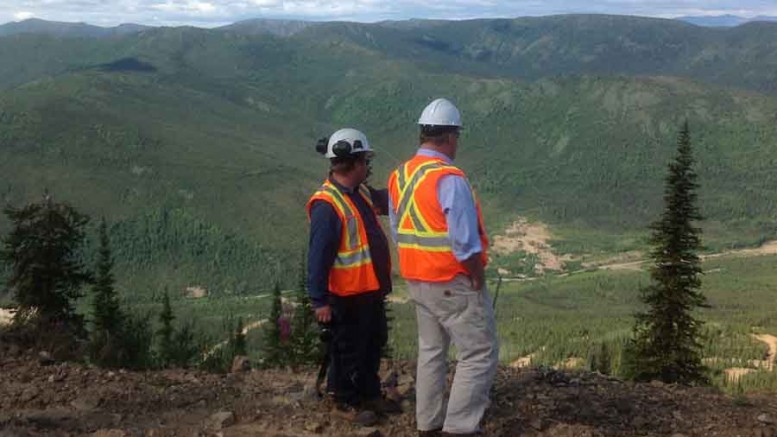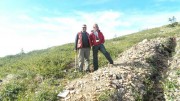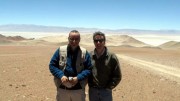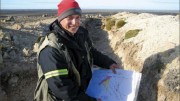It has been a three-year slog for Toronto-based Victoria Gold (VIT-V) at its wholly owned Dublin Gulch property 85 km from Mayo, Yukon, but the company is nearing the finish line to put its Eagle gold deposit into production by 2015.
Driving into Victoria’s 100-person camp on an all-season gravel roadway, it’s clear that the company is well on its way in building a 29,500-tonne-per-day open-pit mine that would yield an average of 192,000 oz. gold annually at a cash cost of US$614 per oz. over a 10-year mine life.
“We have the mine-building team in place,” president and CEO John McConnell comments during a presentation at Victoria’s on-site offices. “It’s a little wild sometimes, because a year ago we had something like fifteen employees, and I think we’re probably around fifty at the moment. By this time next year we should hit around one-hundred and fifty workers.”
Standing on tree-lined hills overlooking the historic Haggart Creek and Victoria camp, vice-president of exploration Rich Eliason points out the locations of a proposed heap-leach pad and gold recovery plant in the valley below. A wooden sign that reads “Centre of Pit” is planted in red-hued dirt on side of the road, signifying the heart of the Eagle deposit.
Gold mineralization at Eagle is hosted in northeast-striking, steeply dipping extensional quartz veins that have been drilled to depths of 500 metres. Reserves total 91.6 million probable tonnes grading 0.78 gram gold per tonne for 2.3 million contained oz. gold.
Victoria released a feasibility study for an open-pit, shovel-and-haul operation in late February. Based on Eagle’s in-pit probable reserves of 2.3 million oz. at an average grade of 0.78 gram gold, the operation would produce 212,000 oz. gold during its first five years at cash costs of US$542 per oz. — with a waste-to-ore ratio of 1.45 to 1 under a three-stage, run-of-mine material crushing design.
Head grades would be a bit higher in the first three years, when 21.6 million tonnes at 0.94 gram gold would be mined.
And more importantly, at US$1,750 per oz. gold, the mine could generate as much as US$258 million in cash flow during its first year of operation.
Using a cut-off grade of 0.2 gram gold and a US$1,325 per oz. gold price, Dublin Gulch carries a US$381 million net present value (NPV) and a 24% internal rate of return (IRR) at a 5% discount rate.
The development would cost US$383 million in initial capital expenditures (capex) and have a payback period of three years. McConnell notes during his presentation that if gold prices continue to trend upward to US$2,000 per oz., the NPV jumps to US$1.2 billion and the IRR soars to 53%.
“The first question I get asked is about how we’re going to raise the required capital,” McConnell says. “And we do have a plan.”
Though the listed capex for the project is under US$400 million, Victoria is attempting to raise an extra US$50 million to bump its cash-on-hand to US$430 million so that it can comfortably move into initial production after an 18- to 24-month construction period.
“What typically kills smaller companies is not having enough working capital at mine start-up,” McConnell says. “So we’re looking to raise over and above the required funding.”
Victoria is sizing up various debt scenarios through a variety of banks with an eye to injecting US$223 million into Dublin Gulch, though McConnell reckons the debt capacity for the project is closer to US$300 million.
Victoria sold its Cove and Mill Canyon gold properties in Nevada earlier this year, and has close to US$70 million in cash and securities from asset sales.
Assuming the company is successful in its fundraising efforts and raises US$40 million through equipment leases, it would have a capital shortfall of US$105 million to meet its goal.
“We’re looking very closely at selling a royalty stream, as the streaming companies are competitive in this environment, and are putting some good term sheets in front of us,” McConnell concludes. “We’ve also looked at the forward sale of gold and a debenture issuance, or bringing in a joint-venture partner. Certainly at our current share price we have no intention of raising money through equity.”
Like many other junior developers, Victoria has taken a bit of a beating through the first half of 2012, with shares falling 43% — or 17¢ through Sept. 9 — on average daily trade volumes of 409,000 shares, en route to a 24¢ press-time close. The company is well below its 52-week high of 56¢ and has 339 million shares outstanding for an $83-million market capitalization. Victoria is 55% institutionally held, with its largest single shareholder being Kinross Gold (K-T, KGC-N), which maintains a 16% stake.
“When you make that first discovery there is a lot of hype, and the speculators are in there driving up the share price,” McConnell comments during his presentation. “But then you hit that boring time where you’re doing feasibility studies and permitting, and the speculators leave. Then the institutions start to take over. We think we’re just about at that point as we move to development and production.”
Dublin Gulch has two advantages that can be taken to market in a bid to acquire its development financing.
Firstly, Victoria’s on-site team enjoys the relatively strong regional infrastructure. Whereas most projects in the Yukon are extremely isolated and force operators to generate power using expensive diesel fuel, Dublin Gulch lies 85 km from a 1,400-metre, government maintained airstrip, and a hydroelectric station and transmission lines service the nearby town of Mayo and the villages of Elsa and Keno City, 25 km southeast of Dublin Gulch.
“This is the first project I’ve worked on in the North that has road access,” McConnell says on the drive back to Victoria’s camp. “It is a big advantage having the infrastructure in the region, especially in regards to having access to hydropower through Mayo, where they’ve just completed tripling the capacity at the station. We have an agreement for them to provide power during construction and operations.”
That agreement will save Victoria a good amount on operating costs. Companies powering their operations with diesel fuel often have to pay in excess of 75¢ per kilowatt hour, but the company’s power-purchase agreement with Yukon Energy entitles it to buy its electricity at 10¢ per kilowatt hour.
Victoria has also developed a good relationship with regional First Nation communities. The company has a signed a Comprehensive Co-operation Benefits Agreement with the local Na-Cho Nyak Dun band under which it provides the community with employment, training and financial support. According to McConnell, working in harmony alongside the First Nation is one of the company’s main goals, and has already provided benefits during permitting and exploration.
“The relationship with the local First Nation is extremely important to the permit process,” McConnell says. “I met with the Yukon Environmental and Socio-Economic Assessment Board (YESAB) a few weeks ago, and the chief of the Na-Cho Nyak Dun came with me. He didn’t really have to say anything, but everyone knows the significance of having that support. Companies have run into plenty of permitting road blocks, based not on an environmental issue, but on not having a good relationship with regional communities.”
Victoria submitted its environmental assessment report in December 2010, and it is still under review. The company announced on Sept. 4 it had reached a permitting milestone when it completed
a draft screening report on Eagle by the YESAB.
Victoria expects its environmental review completed by early 2013, with construction scheduled to kick-start in the first few months of 2013, after the company receives its quartz-mining licence.
In addition to expediting permitting, a good relationship with the First Nation has allowed access to additional land concessions in the area.
In December, Victoria signed a letter of intent with the Na-Cho Nyak Dun to stake 290 sq. km of greenfield land adjacent to Dublin Gulch, expanding the project to 3,408 claims over 646 sq. km. The VBW and VBS claim blocks lie west and south of Eagle, respectively, and McConnell notes the trend from the deposit appears to strike right onto the newly acquired western block. Scout work is scheduled on the new claims over the next several months.
On the exploration front Victoria has done a lot of reconnaissance work over the past two years, with a focus on potential deposits within trucking distance of Eagle. The company has identified mineral trends over 13 km, and maintains three active exploration targets at Dublin Gulch — namely the Shamrock, Olive and Rex-Peso zones.
Shamrock and Olive are targets that have been highlighted by similar gold grades to Eagle. In mid-January Victoria released assay results highlighted by 38 metres averaging 1.22 grams gold at Shamrock in hole 11-454C, and 23 metres carrying 0.72 gram gold at Olive in hole 11-466C.
Rex-Peso is a silver target along the southwestern extension of the Potato Hills mineralized belt. Victoria confirmed significant silver-lead-antimony mineralization in early January when it released results from the Rex and Peso veins, which included: 27.4 metres averaging 382 grams silver in hole 11RPDH-10 at the Rex vein, and 15.8 metres carrying 83 grams silver in hole 11RPDH-02 at the Peso vein.
“If you look at drill holes from areas like Shamrock and Rex-Peso, we think it represents the best opportunity to find more Eagle-style mineralization,” McConnell points out.
Victoria completed an additional 17,000-metre delineation program at the main Eagle deposit in a bid to release an updated resource by the end of the year. The company is focusing on Eagle’s 134 million indicated tonnes averaging 0.69 gram gold for 3 million contained oz. gold.
“Our winter program was aimed at expanding the resource and on our confidence in the pit material, as well as the geology and alteration,” Eliason concludes. “We cut some good thickness and good grades, and some of it starts within around thirty metres of surface. One of the unique things about us is that we’ve got a good combination of shops and equipment, so we can drill all year.”





Be the first to comment on "Victoria rules at Dublin Gulch in Yukon"